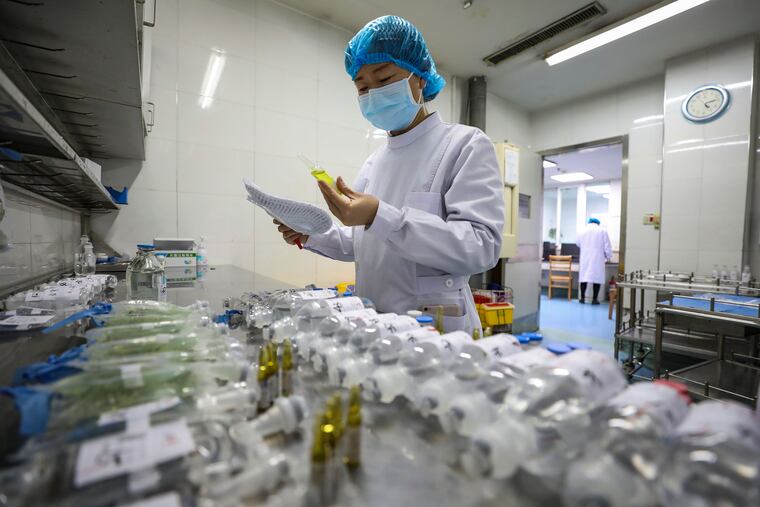Coronavirus hasn’t hit Pa., but health officials must prepare for the unknown. Here’s what’s happening.
As scientific understanding of the virus evolves, experts wonder whether those preparations will fall short.

On Wednesday, hundreds of hospital leaders from Pennsylvania and across the country met with top federal public health officials in Washington to discuss preparedness for the coronavirus dubbed COVID-19.
With 29 confirmed cases, including evacuees from a cruise ship in Japan, the United States is deemed at low risk of an outbreak of the respiratory illness, which emerged in late December in Wuhan, China. Most states, including Pennsylvania and New Jersey, have had no cases.
Yet the mood at the Washington meeting was anything but complacent, said infectious-disease specialist Patrick J. Brennan, chief medical officer of the University of Pennsylvania Health System.
“There’s a tremendous amount that’s unknown. For example, I asked about the duration of viral shedding,” Brennan said Thursday, referring to the fact that people can release certain viruses they are carrying without showing symptoms. “The answer is: We just don’t know.”
Echoed another attendee, Mark Ross, vice president for emergency management at the Hospital and Healthsystem Association of Pennsylvania, “There are still a lot of unanswered questions about transmissibility, about how long the virus lasts on surfaces, about asymptomatic infection.”
Protectors of public health are making coronavirus preparations based on experience with other diseases and guidance from the U.S. Centers for Disease Control and Prevention and the World Health Organization. But as scientific understanding of the virus evolves, experts wonder if those preparations will fall short.
For example, if Philadelphia were to have a confirmed case, the Department of Public Health could immediately mobilize its four disease surveillance investigators to find and quarantine people who came in contact with the infected person. If more staff were needed, similarly trained workers would be enlisted. After two weeks — the virus’ incubation period — people with no fever or other symptoms would be presumed to be uninfected.
The problem is that the CDC does not advise testing asymptomatic people — even though this week it said people without symptoms can transmit the virus. That deduction was based on the rate of new infections among several hundred U.S. citizens who were evacuated from a cruise ship quarantined in Japan. Two recent reports in the New England Journal of Medicine also provide evidence of symptom-free transmission, a phenomenon that would make the job of containing the virus much more difficult.
“The fact is that testing is very limited at this point, partly because of the CDC suspected-case definition, and partly because of a lack of testing capacity,” said James Garrow, spokesperson for Philadelphia’s health department. “We are hamstrung by” not having a fast, convenient screening test.
» READ MORE: How the coronavirus ‘jumped’ to humans is a story as old as evolution
On the positive side, Pennsylvania, and Philadelphia in particular, is well-equipped for an outbreak that might suddenly send a big wave of coronavirus patients to hospitals.
When an Amtrak train derailed in 2015, Ross noted, “218 unannounced patients were rushed to Philadelphia hospitals without stressing the system.”
In China, the health system was under such strain that the government erected an emergency hospital in 10 days. So far, the country has reported more than 75,000 cases and 2,100 deaths; millions of Hubei province residents remain under virtual lockdown at home.
Philadelphia’s medical centers also have the kind of high technology that is required for effective infection control (such as isolation rooms with special ventilation systems) and for critical respiratory care (such as heart-lung bypass machines called ECMO).
Up to 30% of COVID-19 patients develop acute respiratory distress syndrome and may be candidates for ECMO, according to an article published in this week’s Journal of the American Medical Association. The authors cautioned that the technology is “resource-intensive, highly specialized, and expensive.”
In recent years, state and local authorities have improved and broadened their emergency communication capabilities. The hospital association next month will repeat a coronavirus webinar on “operational, legal and financial readiness.” The city health department, which revised its pandemic flu plan in 2018, issues daily email updates on coronavirus to the media.
The city also has alert networks — including a secure, web-based system — to disseminate information to officials, first responders, health-care providers, volunteers, and other partners, said Jessica Caum, manager of the health department’s public health preparedness program.
She added that this year, the health department held two workshops to figure out how to provide such everyday things as groceries and child care to people quarantined at home.
“It became clear with the [2014] Ebola cases in Texas that planning for that is important,” Caum said.